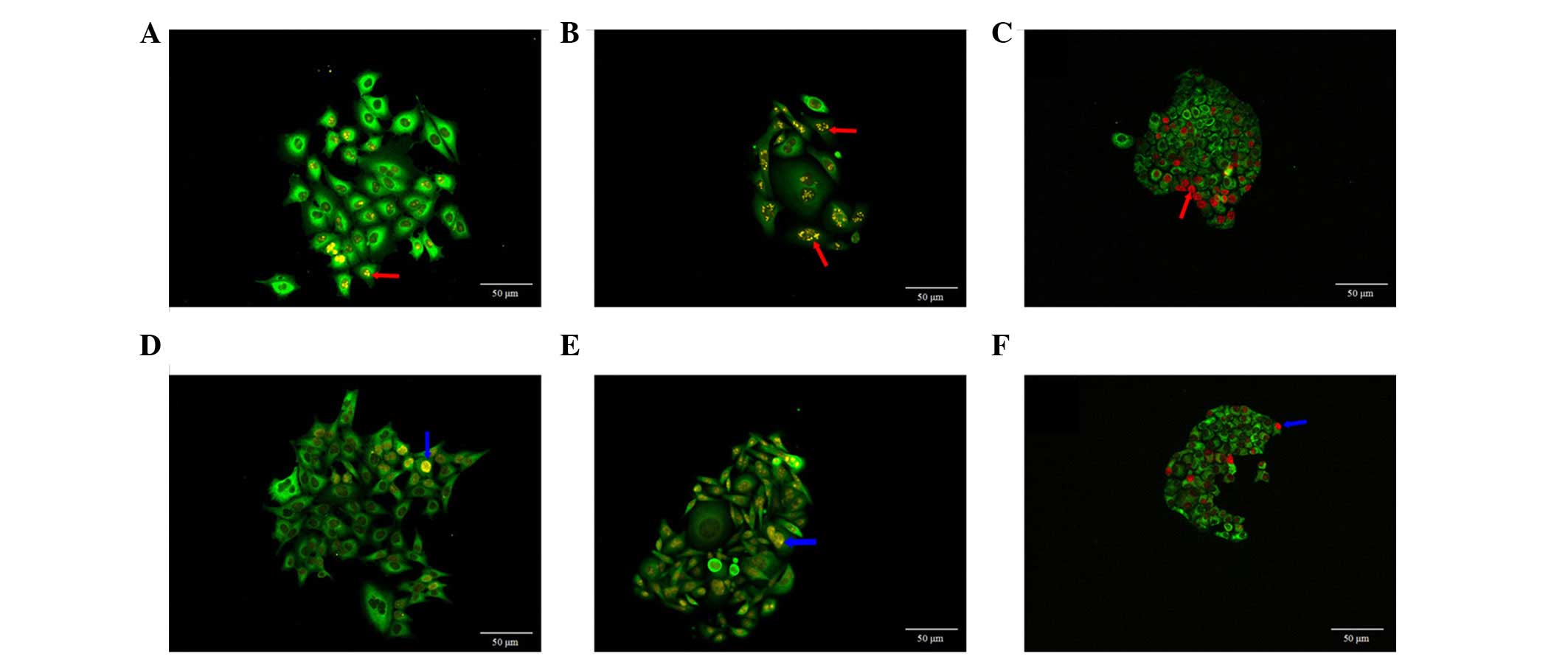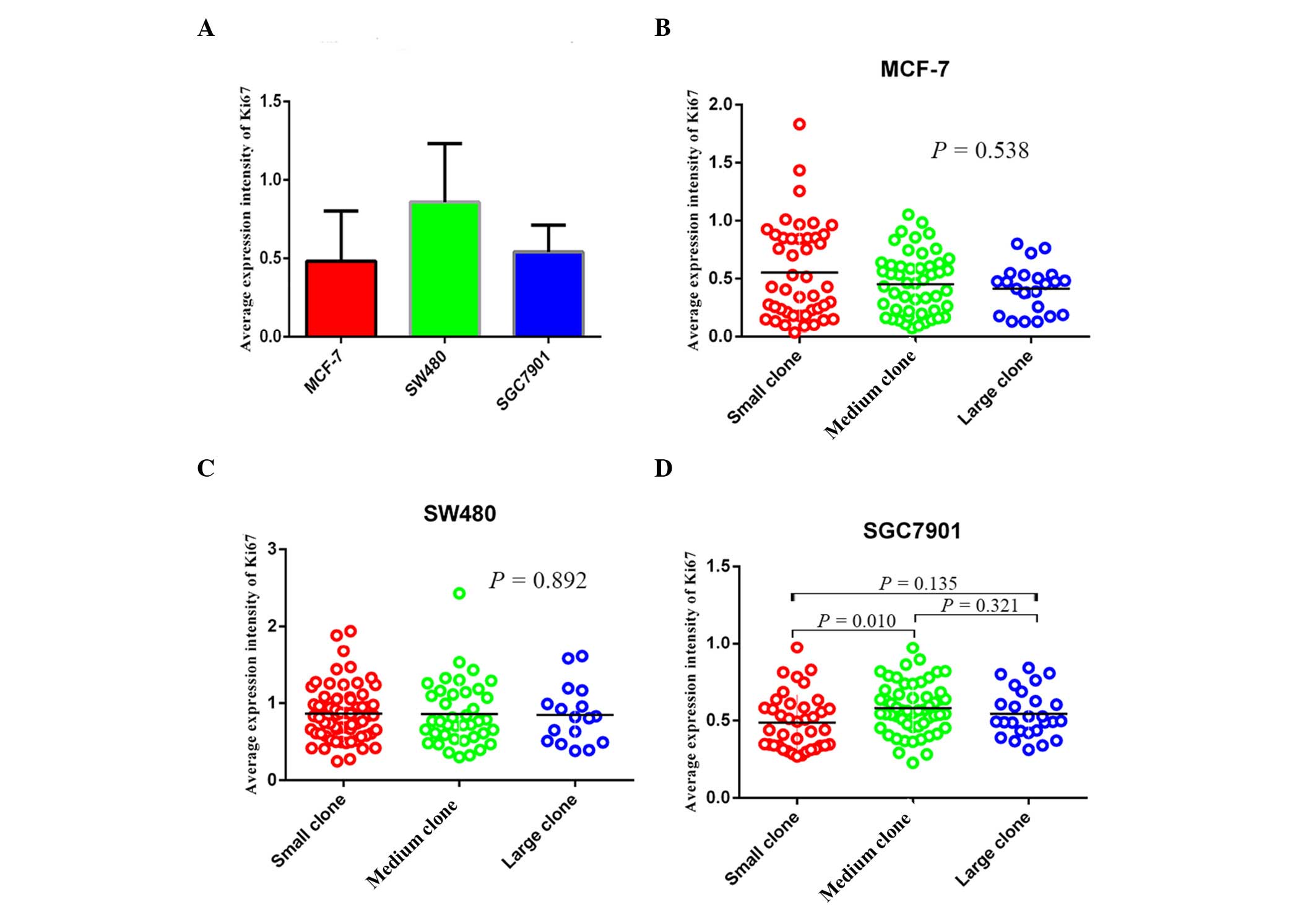|
1
|
Dowsett M, Nielsen TO, A'Hern R, Bartlett
J, Coombes RC, Cuzick J, Ellis M, Henry NL, Hugh JC, Lively T, et
al: Assessment of Ki67 in breast cancer: Recommendations from the
international Ki67 in breast cancer working group. J Natl Cancer
Inst. 103:1656–1664. 2011. View Article : Google Scholar : PubMed/NCBI
|
|
2
|
Soltysova A, Altanerova V and Altaner C:
Cancer stem cells. Neoplasma. 52:435–440. 2005.PubMed/NCBI
|
|
3
|
Franken NA, Rodermond HM, Stap J, Haveman
J and van Bree C: Clonogenic assay of cells in vitro. Nat Protoc.
1:2315–2319. 2006. View Article : Google Scholar
|
|
4
|
Munshi A, Hobbs M and Meyn RE: Clonogenic
cell survival assay. Methods Mol Med. 110:21–28. 2005.PubMed/NCBI
|
|
5
|
Scholzen T and Gerdes J: The Ki-67
protein: From the known and the unknown. J Cell Physiol.
182:311–322. 2000. View Article : Google Scholar : PubMed/NCBI
|
|
6
|
He X, Chen Z, Fu T, Jin X, Yu T, Liang Y,
Zhao X and Huang L: Ki-67 is a valuable prognostic predictor of
lymphoma but its utility varies in lymphoma subtypes: evidence from
a systematic meta-analysis. BMC Cancer. 14:1532014. View Article : Google Scholar : PubMed/NCBI
|
|
7
|
Wang LW, Qu AP, Liu WL, Chen JM, Yuan JP,
Wu H, Li Y and Liu J: Quantum dots-based double imaging combined
with organic dye imaging to establish an automatic computerized
method for cancer Ki67 measurement. Sci Rep. 6:205642016.
View Article : Google Scholar : PubMed/NCBI
|
|
8
|
Weng KC, Nobel CO,
Papahadjopolous-Sternberg B, Chen FF, Drummond DC, Kirpotin DB,
Wang D, Hom YK, Hann B and Park JW: Targeted tumor cell
internalization and imaging of multifunctional quantum
dot-conjugated immunoposomes in vitro and in vivo. Nano Lett.
8:2851–2857. 2008. View Article : Google Scholar : PubMed/NCBI
|
|
9
|
Gokarna A, Jin LH, Hwang JS, Cho YH, Lim
YT, Chung BH, Youn SH, Choi DS and Lim JH: Quantum dot-based
protein micro- and nanarrays for detection of prostate cancer
biomarkers. Proteomics. 8:1809–1818. 2008. View Article : Google Scholar : PubMed/NCBI
|
|
10
|
Chen LD, Liu J, Yu XF, He M, Pei XF, Tang
ZY, Wang QQ, Pang DW and Li Y: The biocompatibility of quantum dot
probes used for the targeted imaging of hepatocellular carcinoma
metastasis. Biomaterials. 29:4170–4176. 2008. View Article : Google Scholar : PubMed/NCBI
|
|
11
|
Chen C, Xia HS, Gong YP, Peng J, Peng CW,
Hu MB, Zhu XB, Pang DW, Sun SR and Li Y: The quantitative detection
of total HER2 load by quantum dots and the identification of a new
subtype of breast cancer with different 5-year prognosis.
Biomaterials. 31:8818–8825. 2010. View Article : Google Scholar : PubMed/NCBI
|
|
12
|
Peng CW, Liu XL, Chen C, Liu X, Yang XQ,
Pang DW, Zhu XB and Li Y: Patterns of cancer invasion revealed by
QDs-based quantitative multiplexed imaging of tumor
microenvironment. Biomaterials. 32:2907–2917. 2011. View Article : Google Scholar : PubMed/NCBI
|
|
13
|
Hamburger AW and Salmon SE: Primary
bioassay of human tumor stem cells. Science. 197:461–463. 1997.
View Article : Google Scholar
|
|
14
|
Chen C, Peng J, Xia HS, Yang GF, Wu QS,
Chen LD, Zeng LB, Zhang ZL, Pang DW and Li Y: Quantum dots-based
immunofluorescence technology for the quantitative determination of
HER2 expression in breast cancer. Biomaterials. 30:2912–2918. 2009.
View Article : Google Scholar : PubMed/NCBI
|
|
15
|
Chen C, Sun SR, Gong YP, Qi CB, Peng CW,
Yang XQ, Liu SP, Peng J, Zhu S, Hu MB, et al: Quantum dots-based
molecular classification of breast cancer by quantitative
spectroanalysis of hormone receptors and HER2. Biomaterials.
32:7592–7599. 2011. View Article : Google Scholar : PubMed/NCBI
|
|
16
|
Fang M, Yuan JP, Peng CW, Pang DW and Li
Y: Quantum dots-based in situ molecular imaging of dynamic changes
of collagen IV during cancer invasion. Biomaterials. 34:8708–8717.
2013. View Article : Google Scholar : PubMed/NCBI
|
|
17
|
Wang FB, Rong Y, Fang M, Yuan JP, Peng CW,
Liu SP and Li Y: Recognition and capture of metastatic
hepatocellular carcinoma cells using aptamer-conjugated quantum
dots and magnetic particles. Biomaterials. 34:3816–3827. 2013.
View Article : Google Scholar : PubMed/NCBI
|
|
18
|
Li X, Pan Y, Fan R, Jin H, Han S, Liu J,
Wu K and Fan D: Adenovirus-delivered CIAPIN1 small interfering RNA
inhibits HCC growth in vitro and in vivo. Carcinogenesis.
29:1587–1593. 2008. View Article : Google Scholar : PubMed/NCBI
|
|
19
|
Plumb JA: Cell sensitivity assays:
Clonogenic assay. Methods Mol Med. 88:159–164. 2004.
|
|
20
|
Frangioni JV: New technologies for human
cancer imaging. J Clin Oncol. 26:4012–4021. 2008. View Article : Google Scholar : PubMed/NCBI
|
|
21
|
Kim J, Piao Y and Hyeon T: Multifunctional
nanostructured materials for multimodal imaging, and simultaneous
imaging and therapy. Chem Soc Rev. 38:372–390. 2009. View Article : Google Scholar : PubMed/NCBI
|
|
22
|
Hong H, Zhang Y, Sun J and Cai W:
Molecular imaging and therapy of cancer with radiolabeled
nanoparticles. Nano Today. 4:399–413. 2009. View Article : Google Scholar :
|
|
23
|
Peng CW, Tian Q, Yang GF, Fang M, Zhang
ZL, Peng J, Li Y and Pang DW: Quantum-dots based simultaneous
detection of multiple biomarkers of tumor stromal features to
predict clinical outcomes in gastric cancer. Biomaterials.
33:5742–5752. 2012. View Article : Google Scholar : PubMed/NCBI
|
|
24
|
Resch-Genger U, Grabolle M,
Cavaliere-Jaricot S, Nitschke R and Nann T: Quantum dots versus
organic dyes as fluorescent labels. Nat Methods. 5:763–775. 2008.
View Article : Google Scholar : PubMed/NCBI
|
|
25
|
Beresford MJ, Wilson GD and Makris A:
Measuring proliferation in breast cancer: Practicalities and
applications. Breast Cancer Res. 8:2162006. View Article : Google Scholar : PubMed/NCBI
|
|
26
|
Brabletz T, Jung A, Spaderna S, Hlubek F
and Kirchner T: Opinion: Migrating cancer stem cells-an integrated
concept of malignant tumour progression. Nat Rev Cancer. 5:744–749.
2005. View
Article : Google Scholar : PubMed/NCBI
|
|
27
|
Watanabe T, Takahashi A, Suzuki K,
Kurusu-Kanno M, Yamaguchi K, Fujiki H and Suganuma M:
Epithelial-mesenchymal transition in human gastric cancer cell
lines induced by TNF-α-inducing protein of Helicobacter pylori. Int
J Cancer. 134:2373–2382. 2013. View Article : Google Scholar
|
|
28
|
Fang M, Yuan J, Peng C and Li Y: Collagen
as a double-edged sword in tumor progression. Tumour Biol.
35:2871–2882. 2014. View Article : Google Scholar :
|
|
29
|
Gong P, Wang Y, Liu G, Zhang J and Wang Z:
New insight into Ki67 expression at the invasive front in breast
cancer. PLoS One. 8:e549122013. View Article : Google Scholar : PubMed/NCBI
|
|
30
|
Fidler IJ: The pathogenesis of cancer
metastasis: The 'seed and soil' hypothesis revisited. Nat Rev
Cancer. 3:453–458. 2003. View
Article : Google Scholar : PubMed/NCBI
|
















